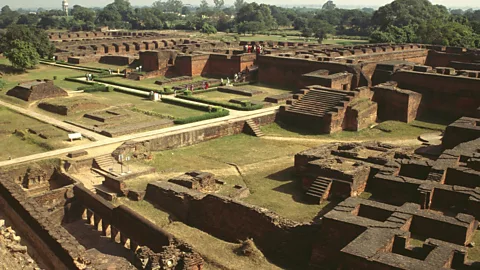In a world where the oldest universities like Oxford boast of nearly a millennium of academic heritage, the revival of Nalanda University in India, a 1400-year-old institution, marks a momentous event in educational history. Once a beacon of knowledge and learning, Nalanda University’s legacy was nearly erased when it was destroyed over 800 years ago. Today, it rises from its ashes, ready to reclaim its position as a premier center of education.
The Glorious Past of Nalanda University
Ancient Legacy and Global Recognition
Nalanda University, established in the 5th century, was a renowned center of learning in ancient India. It attracted scholars from all over Asia, including regions like Korea, Japan, Mongolia, Turkey, and Sri Lanka. The university offered a diverse range of subjects such as logic, grammar, medicine, arts, mathematics, astronomy, and spirituality.

The Tragic Destruction
In a tragic event that occurred 831 years ago, the university was set ablaze, and its vast repository of knowledge was reduced to ashes. Persian historian Minhaj-i-Siraj described the devastation, noting that the burning books caused immense grief as centuries of records were lost forever. The destruction of Nalanda was a calculated attempt to obliterate India’s soft power and educational heritage.
The Impact of Nalanda’s Destruction on India
A Setback for Indian Progress
The destruction of Nalanda University had far-reaching consequences for India’s development. Had Nalanda survived, India might have become a developed nation much earlier. The university was a symbol of India’s intellectual prowess and its loss set the nation back significantly.
The Golden Bird: India’s Lost Glory
India was once referred to as the “Golden Bird” due to its immense resources and knowledge. The foreign invaders exploited these resources, changing the course of Indian history. The education provided by Nalanda University was instrumental in maintaining India’s status as a leading nation. Its destruction hindered India’s progress and contributed to the erosion of its rich educational heritage.
History of Nalanda University
Nalanda University was founded in the 5th century by Kumaragupta I, ruler of the Gupta dynasty. The university became famous as a Buddhist monastery and scholarly institution. Its huge library, known as Dharmaganja, housed innumerable manuscripts and texts on science, mathematics, astronomy, medicine, literature and Buddhist scriptures.

In 1193 AD, the Turkish Muslim general Bakhtiar Khilji invaded Nalanda University and set its great library on fire. This incident caused great damage to India’s intellectual and cultural heritage. The Nalanda University library contained so many manuscripts and texts that it burned for months. This devastating incident played a significant role in the decline of Buddhism in India.
The historical importance of Nalanda University and its scholarship continue to be a source of inspiration for modern educational and cultural initiatives.
The Revival of Nalanda University
Dr. APJ Abdul Kalam’s Vision
The revival of Nalanda University began with the vision of Dr. APJ Abdul Kalam, who in 2006 proposed the idea of resurrecting the ancient institution. This vision materialized with the passing of the Nalanda University Act in 2010, leading to the establishment of a legal framework for its reconstruction.
Modern Nalanda: A Blend of Tradition and Innovation
In June 2024, Nalanda University was inaugurated on a sprawling 455-acre campus, equipped with modern technologies such as rainwater harvesting, solar power, and solar parks. The new campus embodies the spirit of ancient Nalanda while incorporating contemporary advancements to foster a holistic learning environment.
The Rich Heritage of Nalanda University
Ancient Knowledge and Manuscripts
Nalanda University was home to thousands of manuscripts and books on ancient mathematics, astronomy, medicine, and various other fields. The knowledge preserved within its walls was unparalleled, and scholars from across the world sought to study there.
International Scholars and Influences
Nalanda’s reputation attracted scholars from various countries. Notable alumni included Xuanzang, a Chinese traveler who documented his experiences at Nalanda, highlighting the university’s influence on international education. Nalanda’s knowledge significantly contributed to the intellectual development of many countries.
The Future of Nalanda University

Restoring Academic Excellence
The revived Nalanda University aims to restore its former glory by providing world-class education and research opportunities. With state-of-the-art facilities and a diverse range of courses, the university is poised to become a global center of learning once again.
Embracing Sustainability and Innovation
The new campus is designed with sustainability in mind, incorporating eco-friendly technologies to reduce its environmental footprint. This commitment to sustainability reflects Nalanda’s dedication to innovative and responsible education.
PM Modi to Inaugurate New Nalanda University Campus | Vantage with Palki Sharma
Conclusion
The revival of Nalanda University is a testament to India’s enduring commitment to education and knowledge. As it reclaims its place among the world’s top universities, Nalanda stands as a symbol of resilience and intellectual heritage. The university’s rich history and promising future make it a beacon of learning for generations to come.
FAQs
Q1: What made Nalanda University unique in ancient times?
A1: Nalanda University was unique due to its extensive collection of manuscripts, diverse range of subjects, and international student body, making it a global center of learning.
Q2: How did the destruction of Nalanda University impact India?
A2: The destruction of Nalanda University was a significant setback for India’s educational and intellectual progress, hindering its development and eroding its rich heritage.
Q3: What is the vision for the revived Nalanda University?
A3: The revived Nalanda University aims to restore its academic excellence, provide world-class education, and embrace sustainability and innovation in its new campus.
Q4: How does the new Nalanda University campus incorporate modern technologies?
A4: The new campus includes rainwater harvesting, solar power, and solar parks, reflecting its commitment to sustainability and innovation.
Q5: What is the significance of Nalanda University’s international influence?
A5: Nalanda’s international influence is significant as it attracted scholars from various countries, contributing to the intellectual development of many regions and establishing India as a global educational leader.
